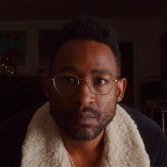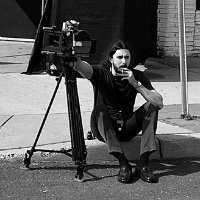
Stuart Brereton
Basic Member-
Posts
3,955 -
Joined
-
Last visited
Profile Information
-
Occupation
Cinematographer
-
Location
Los Angeles
Contact Methods
-
Website URL
https://www.stuartbrereton.com
Recent Profile Visitors
-
I bought a Dana Dolly about 12 years ago. It was about $1000 dollars for the full kit. It paid for itself in rentals in less than 6 months. Built like a tank, and very smooth. There's a reason you'll find one on just about every grip truck
-
Dana Dolly track has 12"/300mm centers. I wouldn't call it a miniature slider though
-
I've just finished a long show in Saudi Arabia, which was set in biblical times. Consequently, we lit a lot with fire at night. The SFX department had a variety of fire gags, all fed from propane gas tanks, which made them very controllable. The issue as a DP is being able to expose for people's faces, while also trying to keep some color and saturation in the flames themselves. Shooting wide open on a fast lens at 800 asa means that the flames will just show as white, so you have to build in your own sources, so that you can have faces exposed at a decent level. I was exposing at around f2.8 - f4 at 800 asa, with faces underexposed by 1.5 stops. That was enough to hold the warm yellow of the flames. Although occasionally I used nothing but firelight to light with, most of the time we were using additional sources to key the actors with. Initially, I was using 2' & 4' Astera tubes to mimic fire effects, and we were also using Aputure BC7 globes inside of the lanterns the actors were holding. I was never happy with the Asteras, and eventually we switched to using little Aputure MC4 LED bricks set to their fire effect. For longer throws, and larger areas we used Skypanel S30s on beaverboards. Real fire is around 2200K, but we never went that low with our lamps. When you head that far into the red end of the spectrum, the color becomes basically monochromatic, and when combined with underexposure, it can get very muddy and indistinct. I generally ran all our lamps at 2800K which was enough to give a warm glow to skin tones and to create a little color contrast with the colder moonlight tones we were creating.
-
That exemption exists to allow News crews to do their job without having to have multiple permits. That why it mentions handheld cameras. It also prevents tourists with handycams from technically breaking the law. A shoot with multiple crew members, and camera and lighting equipment blocking sidewalks is still going to attract attention from the police. it also specifically mentions not causing obstructions. What is locking up a road, if not causing an obstruction? Of course, safety is a separate issue from permits, and I’m glad that you seem to understand the issues, even if some people are determined to give you poor advice.
-
This shoot is in LONDON. Shooting in London without a permit is ILLEGAL Shooting in the street without a proper lock up is DANGEROUS. Locking up a street without a permit is DANGEROUS AND ILLEGAL Stop advising people to risk their safety and break the law. It is highly irresponsible. As usual, you're so desperate to be right that you won't listen to any of the numerous people who have told you why this is a bad idea.
-
What an asinine comment. That is exactly the kind of thinking that gets people hurt. There is no shot that is worth risking injury or death to get. It was that attitude that got Sarah Jones killed, and expressing it here, under the guise of offering help, is highly irresponsible and offensive. I sincerely hope you are not passing on such ridiculous advice to those poor unfortunates you have as “students”.
-
That sounds like an attempt to avoid responsibility for giving bad advice. The OP clearly stated that they intended to be working on multiple streets in the same shot, at night, in London. I don't know if you've ever visited, but it's not some sleepy little town with "one or two cars every minute". What you are suggesting is dangerous and illegal.
-
Contax Zeiss vs Leica R?
Stuart Brereton replied to Jonathan Breiner's topic in Lenses & Lens Accessories
Both sets of lenses are very capable and very sharp. Leica R are extremely popular as rehoused sets, Contax Zeiss less so, but that may be because Zeiss Superspeeds offer an affordable alternative. The issues that you'll find are common to just about all cine-modded lenses: the lack of a uniform maximum aperture, and a short focus throw. If you're shooting at f2.8 or above, the aperture won't be a problem, and using a remote focus unit where the focus scale can be mapped over the full 360º of the wheel will mitigate the shortness of the throw. You say that Lomos would be your first choice. To me, that says you're looking for slightly softer, lower contrast lenses, so you may want to look at older, single coated glass like Nikon Autos or Super Takumars, if you can find a set in LA. Canon FL, or older FD would be another good alternative, but you'd need to find a set that had had the mounts converted to EF. There's also a plethora of old Russian glass that's available in M42 mount. You won't be able to find a matched set of anything, but there some great lenses out there. Even the Helios 44-2 is capable of much more than just 'swirly bokeh'. As an aside, it's probably helpful to stop thinking about "Crop Factors". A 50mm lens is a 50mm lens. It doesn't change. It's much simpler just to learn what each focal length looks like on s35, rather than have to do math every time you swing a lens. EDIT: Old Fast Glass in Sun Valley have cine-modded sets of Canon FD and Nikon Ai. Lovely lenses dating back to the mid '70s - early '80s -
Diopters for aesthetics not close focus
Stuart Brereton replied to Pete Raynell's topic in General Discussion
That's exactly my point ? The diopter is not being used to compensate for a lack of close focus ability in the lens. That's why I asked Peter where the lens was focused after the diopter was added. I tend to agree with Daniel that this is most likely something of a magic trick designed to wow the people at video village. Either that, or just one of those weird myths that gets passed around without ever being properly tested. I've actually heard someone fairly high up in sales at Zeiss telling people this "trick" as well. -
Underexposing KV3 7219
Stuart Brereton replied to Alberto Bañares 's topic in Film Stocks & Processing
You shoot gray scales at the beginning of each scene. You don't need to do it after reloading unless it's also a new scene. It’s been done without problems for decades. Thanks for the heads up, I had no idea. I'm sure Panavision are terrified about the competition. We're obviously firmly in Fantasyland now, so I'll leave you to it. -
Diopters for aesthetics not close focus
Stuart Brereton replied to Pete Raynell's topic in General Discussion
But it doesn't, that's the problem. In my first two stills, the Canon camera is just a few inches behind the in-focus lens. The wall behind it is 7 feet back. The camera appears equally soft in both frames, as does the wall. In Pete's second post, he clearly states that the background was 50' away -
Diopters for aesthetics not close focus
Stuart Brereton replied to Pete Raynell's topic in General Discussion
How can things be softer if they are closer to the plane of focus? In the stills I posted above, the lamppost in the center of frame is only about 10-12 feet away. Both appear equally soft. In my first post, I had two frames where the background was only 7ft back from the camera. Again, there was virtually no difference between the diopter and non diopter shot. I would love to be able to replicate this effect, as it's a useful trick if it works, but so far, I can't see a difference. -
Options for a budget friendly balloon light?
Stuart Brereton replied to Roger Alexander's topic in Lighting for Film & Video
You may already know this, but pretty much the most expensive part of any balloon light is the helium that goes in it. -
Underexposing KV3 7219
Stuart Brereton replied to Alberto Bañares 's topic in Film Stocks & Processing
So the process is that they let each roll run from beginning to end. No interruption, no alterations. So it's not that they are "missing" your underexposed shots, or not trying hard enough, it's just that individual corrections are not part of the service. That's kind of what I thought would be the issue. Gray scales are used to communicate exposure and color filtration information to other people further down the post production line. How is someone supposed to know how your flat scan should look if there's nothing to reference? Even if it's a personal project, running a gray scale takes only seconds and you never know when someone else might need to see it. It's just basic professional practice. Of course it's your job. The AC is not writing those notes for fun. It is the DP's responsibility to communicate to the labs via those notes. When I was an AC, I worked for DPs who would make you write the whole report out a second time if you made a mistake on it. They wanted every detail on there so that both the lab and editorial knew exactly what their intentions were, so there were no mistakes. I certainly wouldn't want to work with a DP who didn't care enough about their images to even make sure the camera reports were correct.











